auto pilot VOLVO XC90 T8 2017 Owner´s Manual
[x] Cancel search | Manufacturer: VOLVO, Model Year: 2017, Model line: XC90 T8, Model: VOLVO XC90 T8 2017Pages: 580, PDF Size: 10.37 MB
Page 8 of 580

6
Start and lock system type designations256
DRIVER SUPPORT
Driver support systems258
Adjustable steering force *
258
Electronic Stability Control (ESC) 259
Electronic Stability Control (ESC) sport mode 260
Electronic Stability Control (ESC)symbols and messages 261
Roll stability control (RSC) 263
Speed limiter (SL) *
263
Starting and activating the Speed Limiter (SL) * 264
Changing a Speed Limiter (SL) *
maximum speed 265
Automatic Speed Limiter (ASL) *
265
Activating/deactivating theAutomatic Speed Limiter (ASL) *267
Changing tolerance for the Automatic Speed Limiter 267
Deactivating/reactivating the Speed Limiter * 268
Turning the Speed Limiter * off
269
Cruise Control (CC) 270
Starting and activating Cruise Control 270
Changing Cruise Control speed 271
Deactivating/resuming Cruise Control (CC) 272
Turning Cruise Control off 273
Switching between Cruise Control and Adaptive Cruise Control*274
Distance Alert *
275
Using Distance Alert *
276
Distance Alert * limitations
277
Adaptive Cruise Control (ACC) *
277
Starting and activating AdaptiveCruise Control (ACC) * 280
Deactivating/resuming Adaptive Cruise Control (ACC) 281
Changing Adaptive Cruise Control(ACC) speed 283
Setting an Adaptive Cruise Controltime interval 284
Passing Assistance with AdaptiveCruise Control or Pilot Assist 285
Changing target vehicles and auto-matic braking with Adaptive CruiseControl (ACC) 285
Adaptive Cruise Control (ACC) -troubleshooting 287
Adaptive Cruise Control (ACC) - limi-tations 288
Adaptive Cruise Control (ACC) sym-bols and messages 289
Pilot Assist *
291
Starting and activating Pilot Assist 294
Changing Pilot Assist speed 296
Page 9 of 580
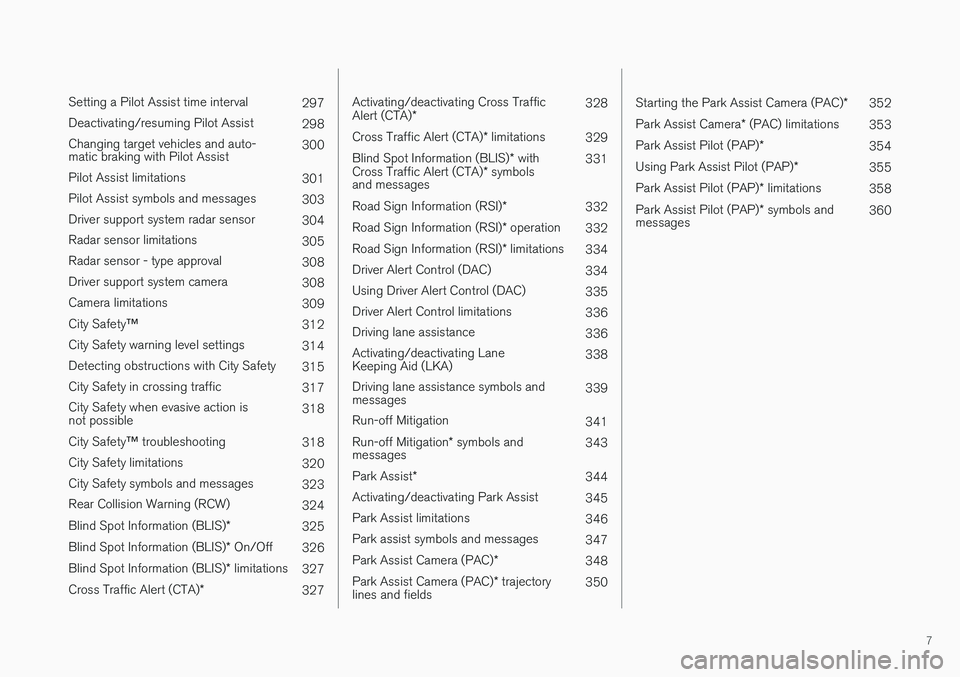
7
Setting a Pilot Assist time interval297
Deactivating/resuming Pilot Assist 298
Changing target vehicles and auto- matic braking with Pilot Assist 300
Pilot Assist limitations 301
Pilot Assist symbols and messages 303
Driver support system radar sensor 304
Radar sensor limitations 305
Radar sensor - type approval 308
Driver support system camera 308
Camera limitations 309
City Safety ™
312
City Safety warning level settings 314
Detecting obstructions with City Safety 315
City Safety in crossing traffic 317
City Safety when evasive action isnot possible 318
City Safety ™ troubleshooting
318
City Safety limitations 320
City Safety symbols and messages 323
Rear Collision Warning (RCW) 324
Blind Spot Information (BLIS) *
325
Blind Spot Information (BLIS) * On/Off
326
Blind Spot Information (BLIS) * limitations
327
Cross Traffic Alert (CTA) *
327
Activating/deactivating Cross Traffic Alert (CTA)* 328
Cross Traffic Alert (CTA) * limitations
329
Blind Spot Information (BLIS) * with
Cross Traffic Alert (CTA) * symbols
and messages 331
Road Sign Information (RSI) *
332
Road Sign Information (RSI) * operation
332
Road Sign Information (RSI) * limitations
334
Driver Alert Control (DAC) 334
Using Driver Alert Control (DAC) 335
Driver Alert Control limitations 336
Driving lane assistance 336
Activating/deactivating Lane Keeping Aid (LKA) 338
Driving lane assistance symbols andmessages 339
Run-off Mitigation 341
Run-off Mitigation * symbols and
messages 343
Park Assist *
344
Activating/deactivating Park Assist 345
Park Assist limitations 346
Park assist symbols and messages 347
Park Assist Camera (PAC) *
348
Park Assist Camera (PAC) * trajectory
lines and fields 350
Starting the Park Assist Camera (PAC)
*
352
Park Assist Camera * (PAC) limitations
353
Park Assist Pilot (PAP) *
354
Using Park Assist Pilot (PAP) *
355
Park Assist Pilot (PAP) * limitations
358
Park Assist Pilot (PAP) * symbols and
messages 360
Page 23 of 580
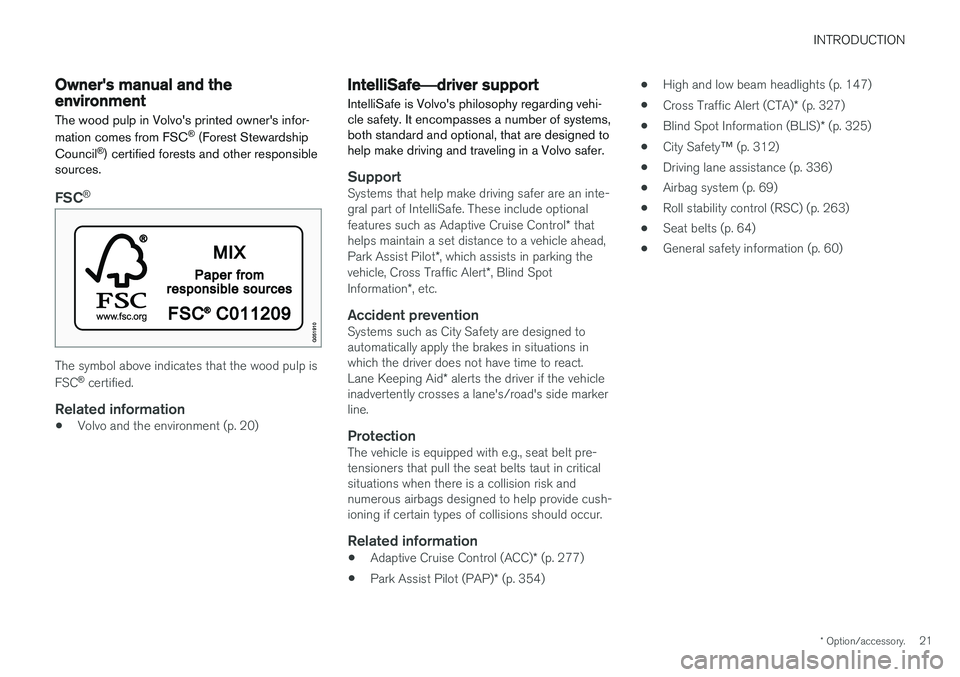
INTRODUCTION
* Option/accessory.21
Owner's manual and the environment
The wood pulp in Volvo's printed owner's infor- mation comes from FSC ®
(Forest Stewardship
Council ®
) certified forests and other responsible
sources.
FSC ®
The symbol above indicates that the wood pulp is FSC
®
certified.
Related information
• Volvo and the environment (p. 20)
IntelliSafe
—driver support
IntelliSafe is Volvo's philosophy regarding vehi- cle safety. It encompasses a number of systems,both standard and optional, that are designed tohelp make driving and traveling in a Volvo safer.
SupportSystems that help make driving safer are an inte- gral part of IntelliSafe. These include optional features such as Adaptive Cruise Control * that
helps maintain a set distance to a vehicle ahead,Park Assist Pilot *, which assists in parking the
vehicle, Cross Traffic Alert *, Blind Spot
Information *, etc.
Accident preventionSystems such as City Safety are designed to automatically apply the brakes in situations inwhich the driver does not have time to react. Lane Keeping Aid * alerts the driver if the vehicle
inadvertently crosses a lane's/road's side marker line.
ProtectionThe vehicle is equipped with e.g., seat belt pre-tensioners that pull the seat belts taut in criticalsituations when there is a collision risk andnumerous airbags designed to help provide cush-ioning if certain types of collisions should occur.
Related information
• Adaptive Cruise Control (ACC)
* (p. 277)
• Park Assist Pilot (PAP)
* (p. 354) •
High and low beam headlights (p. 147)
• Cross Traffic Alert (CTA)
* (p. 327)
• Blind Spot Information (BLIS)
* (p. 325)
• City Safety
™ (p. 312)
• Driving lane assistance (p. 336)
• Airbag system (p. 69)
• Roll stability control (RSC) (p. 263)
• Seat belts (p. 64)
• General safety information (p. 60)
Page 282 of 580
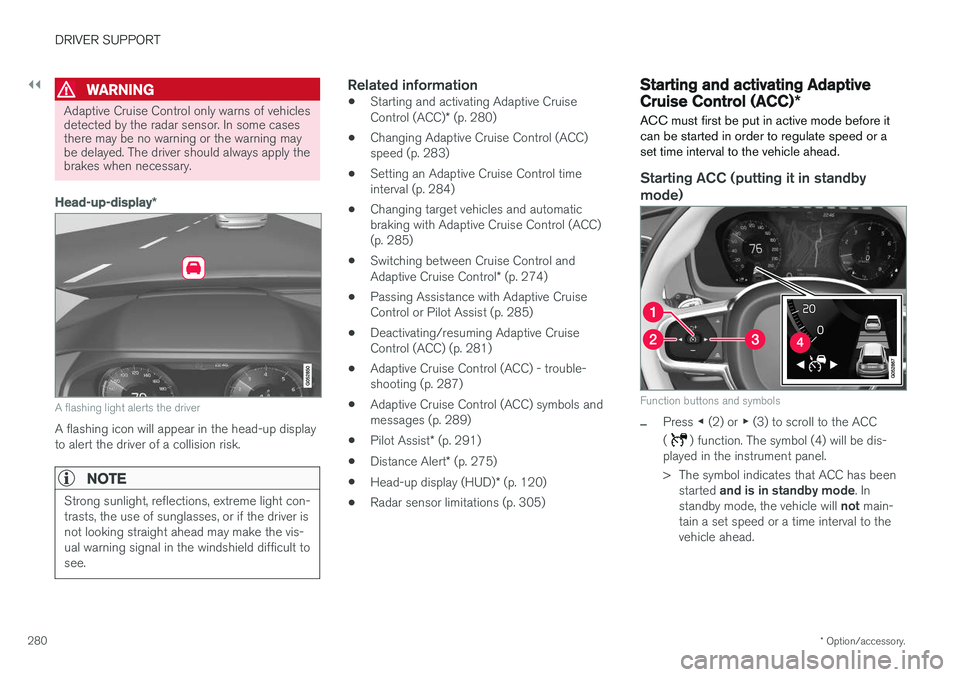
||
DRIVER SUPPORT
* Option/accessory.
280
WARNING
Adaptive Cruise Control only warns of vehicles detected by the radar sensor. In some casesthere may be no warning or the warning maybe delayed. The driver should always apply thebrakes when necessary.
Head-up-display *
A flashing light alerts the driver
A flashing icon will appear in the head-up display to alert the driver of a collision risk.
NOTE
Strong sunlight, reflections, extreme light con- trasts, the use of sunglasses, or if the driver isnot looking straight ahead may make the vis-ual warning signal in the windshield difficult tosee.
Related information
•Starting and activating Adaptive Cruise Control (ACC)
* (p. 280)
• Changing Adaptive Cruise Control (ACC) speed (p. 283)
• Setting an Adaptive Cruise Control timeinterval (p. 284)
• Changing target vehicles and automaticbraking with Adaptive Cruise Control (ACC)(p. 285)
• Switching between Cruise Control and Adaptive Cruise Control
* (p. 274)
• Passing Assistance with Adaptive Cruise Control or Pilot Assist (p. 285)
• Deactivating/resuming Adaptive CruiseControl (ACC) (p. 281)
• Adaptive Cruise Control (ACC) - trouble-shooting (p. 287)
• Adaptive Cruise Control (ACC) symbols andmessages (p. 289)
• Pilot Assist
* (p. 291)
• Distance Alert
* (p. 275)
• Head-up display (HUD)
* (p. 120)
• Radar sensor limitations (p. 305)
Starting and activating Adaptive Cruise Control (ACC)
*
ACC must first be put in active mode before it can be started in order to regulate speed or aset time interval to the vehicle ahead.
Starting ACC (putting it in standby
mode)
Function buttons and symbols
–Press ◀ (2) or ▶ (3) to scroll to the ACC
(
) function. The symbol (4) will be dis-
played in the instrument panel.
> The symbol indicates that ACC has been
started and is in standby mode . In
standby mode, the vehicle will not main-
tain a set speed or a time interval to the vehicle ahead.
Page 287 of 580

DRIVER SUPPORT
}}
* Option/accessory.285
Passing Assistance with Adaptive Cruise Control or Pilot Assist
ACC or Pilot Assist can assist the driver when passing other vehicles.
How passing assistance worksWhen ACC or Pilot Assist is following another vehicle and the driver indicates that he/she isabout to pass that vehicle by using the left turnsignal, ACC or Pilot Assist will begin acceleratingtoward the vehicle ahead before your vehicle hasmoved into the passing lane. The function will then delay a speed reduction to avoid early braking as your vehicle approachesthe slower-moving vehicle. The function is active until your vehicle has passed the other vehicle.
WARNING
Be aware that this function may be activated in situations other than when passing a vehi-cle, such as if the turn signal is used to indi-cate a lane change or to indicate a turn. Thevehicle will accelerate briefly.
Using passing assistanceTo activate passing assistance:
• Your vehicle (ACC or Pilot Assist) must be following another vehicle (the target vehicle).
• Current speed must be at least approx.45 mph (70 km/h ). •
The speed set for ACC or Pilot Assist mustbe high enough to safely pass the vehicleahead.
Starting passing assistanceTo start a passing assistance sequence:
• Activate the left turn signal.
Passing assistance limitations
WARNING
The driver should be prepared for sudden changes when passing assistance is used. Incertain cases, there may be undesired accel-eration. Certain situations should be avoided, such as: • If the vehicle is approaching an exit to the left or a left turn.
• If the vehicle ahead slows down beforeyour vehicle has moved into the passinglane.
• Traffic in the passing lane slows down.
Passing assistance in these situations can bedeactivated by putting ACC or Pilot Assist instandby mode.
Related information
• Pilot Assist
* (p. 291)
• Adaptive Cruise Control (ACC)
* (p. 277)
Changing target vehicles and automatic braking with AdaptiveCruise Control (ACC)
At certain speeds, Adaptive Cruise Control can change target vehicles and automatically applythe brakes.
Changing target vehicles
If the target vehicle turns suddenly, there may be a sta- tionary vehicle ahead
When ACC is actively following another vehicle at speeds under 20 mph (30 km/h) and changes
targets from a moving vehicle to a stationary one, the system will brake for the stationary vehicle.
Page 293 of 580
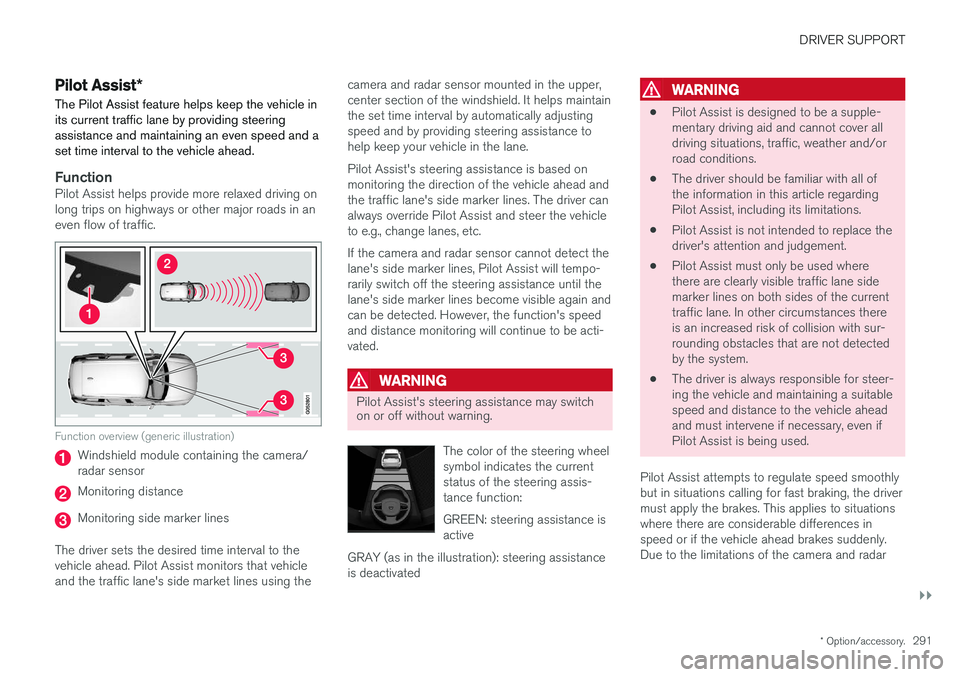
DRIVER SUPPORT
}}
* Option/accessory.291
Pilot Assist*
The Pilot Assist feature helps keep the vehicle in its current traffic lane by providing steeringassistance and maintaining an even speed and aset time interval to the vehicle ahead.
FunctionPilot Assist helps provide more relaxed driving on long trips on highways or other major roads in aneven flow of traffic.
Function overview (generic illustration)
Windshield module containing the camera/ radar sensor
Monitoring distance
Monitoring side marker lines
The driver sets the desired time interval to the vehicle ahead. Pilot Assist monitors that vehicleand the traffic lane's side market lines using the camera and radar sensor mounted in the upper,center section of the windshield. It helps maintainthe set time interval by automatically adjustingspeed and by providing steering assistance tohelp keep your vehicle in the lane. Pilot Assist's steering assistance is based on monitoring the direction of the vehicle ahead andthe traffic lane's side marker lines. The driver canalways override Pilot Assist and steer the vehicleto e.g., change lanes, etc. If the camera and radar sensor cannot detect the lane's side marker lines, Pilot Assist will tempo-rarily switch off the steering assistance until thelane's side marker lines become visible again andcan be detected. However, the function's speedand distance monitoring will continue to be acti-vated.
WARNING
Pilot Assist's steering assistance may switch on or off without warning.
The color of the steering wheel symbol indicates the currentstatus of the steering assis-tance function: GREEN: steering assistance is active
GRAY (as in the illustration): steering assistanceis deactivated
WARNING
• Pilot Assist is designed to be a supple- mentary driving aid and cannot cover alldriving situations, traffic, weather and/orroad conditions.
• The driver should be familiar with all ofthe information in this article regardingPilot Assist, including its limitations.
• Pilot Assist is not intended to replace thedriver's attention and judgement.
• Pilot Assist must only be used wherethere are clearly visible traffic lane sidemarker lines on both sides of the currenttraffic lane. In other circumstances thereis an increased risk of collision with sur-rounding obstacles that are not detectedby the system.
• The driver is always responsible for steer-ing the vehicle and maintaining a suitablespeed and distance to the vehicle aheadand must intervene if necessary, even ifPilot Assist is being used.
Pilot Assist attempts to regulate speed smoothlybut in situations calling for fast braking, the drivermust apply the brakes. This applies to situationswhere there are considerable differences inspeed or if the vehicle ahead brakes suddenly.Due to the limitations of the camera and radar
Page 296 of 580
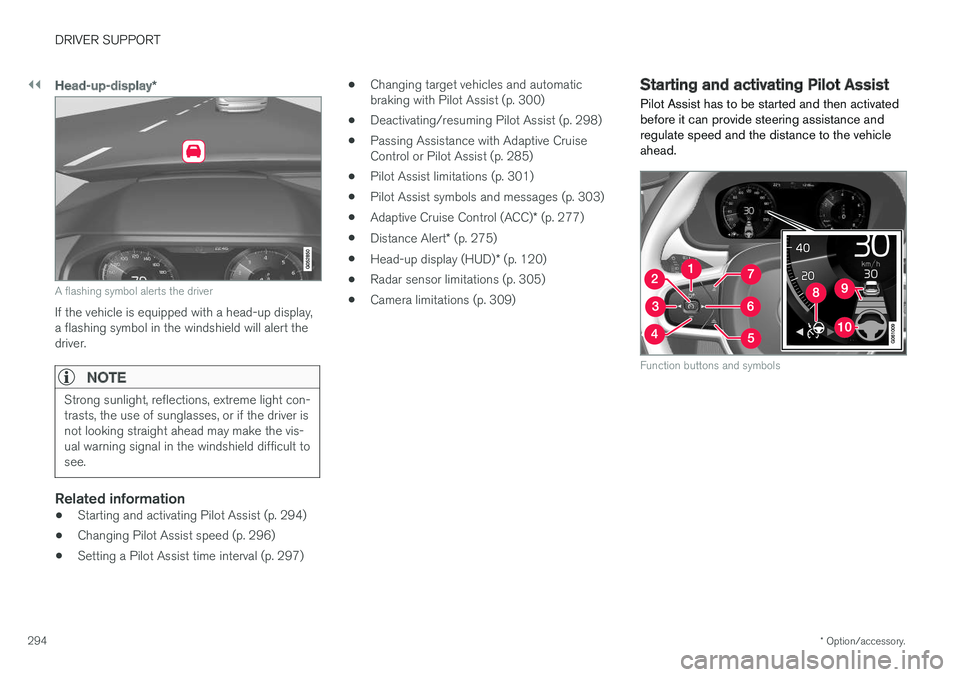
||
DRIVER SUPPORT
* Option/accessory.
294
Head-up-display *
A flashing symbol alerts the driver
If the vehicle is equipped with a head-up display, a flashing symbol in the windshield will alert thedriver.
NOTE
Strong sunlight, reflections, extreme light con- trasts, the use of sunglasses, or if the driver isnot looking straight ahead may make the vis-ual warning signal in the windshield difficult tosee.
Related information
•Starting and activating Pilot Assist (p. 294)
• Changing Pilot Assist speed (p. 296)
• Setting a Pilot Assist time interval (p. 297) •
Changing target vehicles and automatic braking with Pilot Assist (p. 300)
• Deactivating/resuming Pilot Assist (p. 298)
• Passing Assistance with Adaptive CruiseControl or Pilot Assist (p. 285)
• Pilot Assist limitations (p. 301)
• Pilot Assist symbols and messages (p. 303)
• Adaptive Cruise Control (ACC)
* (p. 277)
• Distance Alert
* (p. 275)
• Head-up display (HUD)
* (p. 120)
• Radar sensor limitations (p. 305)
• Camera limitations (p. 309)
Starting and activating Pilot Assist
Pilot Assist has to be started and then activated before it can provide steering assistance andregulate speed and the distance to the vehicleahead.
Function buttons and symbols
Page 297 of 580
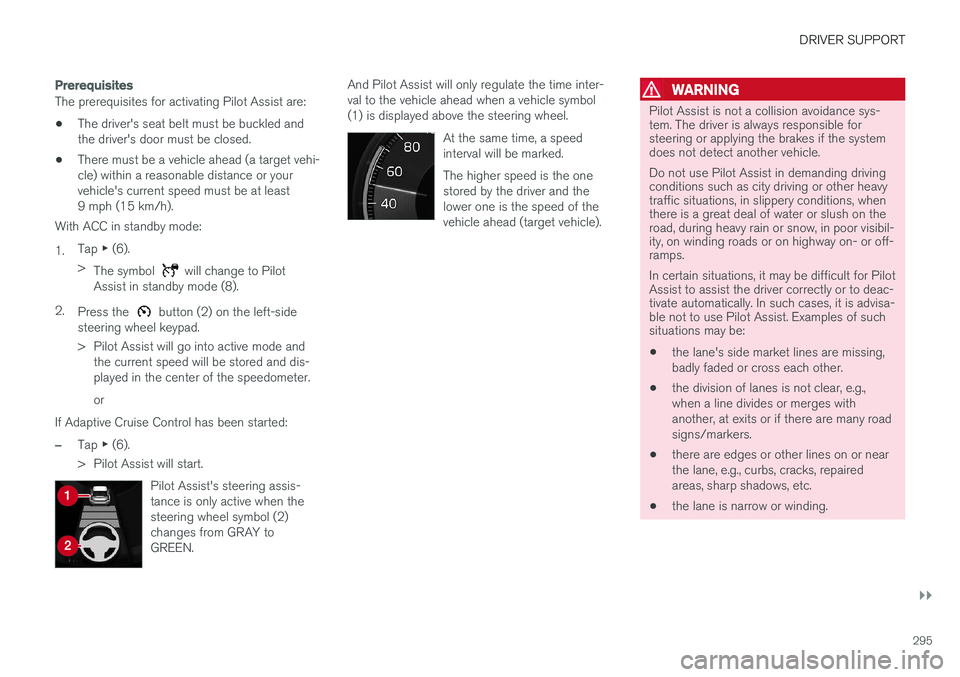
DRIVER SUPPORT
}}}}
295
Prerequisites
The prerequisites for activating Pilot Assist are:• The driver's seat belt must be buckled and the driver's door must be closed.
• There must be a vehicle ahead (a target vehi-cle) within a reasonable distance or yourvehicle's current speed must be at least9 mph (15 km/h).
With ACC in standby mode: 1. Tap
▶ (6).
> The symbol
will change to Pilot
Assist in standby mode (8).
2. Press the
button (2) on the left-side
steering wheel keypad.
> Pilot Assist will go into active mode and the current speed will be stored and dis- played in the center of the speedometer. or
If Adaptive Cruise Control has been started:
–Tap ▶ (6).
> Pilot Assist will start.
Pilot Assist's steering assis- tance is only active when thesteering wheel symbol (2)changes from GRAY toGREEN.
And Pilot Assist will only regulate the time inter- val to the vehicle ahead when a vehicle symbol(1) is displayed above the steering wheel. At the same time, a speedinterval will be marked. The higher speed is the one stored by the driver and thelower one is the speed of thevehicle ahead (target vehicle).WARNING
Pilot Assist is not a collision avoidance sys- tem. The driver is always responsible forsteering or applying the brakes if the systemdoes not detect another vehicle. Do not use Pilot Assist in demanding driving conditions such as city driving or other heavytraffic situations, in slippery conditions, whenthere is a great deal of water or slush on theroad, during heavy rain or snow, in poor visibil-ity, on winding roads or on highway on- or off-ramps. In certain situations, it may be difficult for Pilot Assist to assist the driver correctly or to deac-tivate automatically. In such cases, it is advisa-ble not to use Pilot Assist. Examples of suchsituations may be:
• the lane's side market lines are missing, badly faded or cross each other.
• the division of lanes is not clear, e.g.,when a line divides or merges withanother, at exits or if there are many roadsigns/markers.
• there are edges or other lines on or nearthe lane, e.g., curbs, cracks, repairedareas, sharp shadows, etc.
• the lane is narrow or winding.
Page 298 of 580

||
DRIVER SUPPORT
* Option/accessory.
296
• the lane is at the top of a hill, on an uneven road surface or over a bump.
• bad weather conditions (rain, snow, fog,slush, poor visibility, backlighting, etc).
The driver should also be aware that Pilot Assist has the following limitations: • High curbs, barriers and temporary obsta- cles (cones, barriers etc) may not bedetected or could be detected incorrectlyas side marker lines, which may create arisk of collision. The driver must ensure asafe distance to these obstacles.
• The camera or radar sensor may not beable to detect objects if there are pot-holes or if there are stationary objectspartially or completely blocking the road.
• Pilot Assist does not "see" pedestrians,animals, etc.
• Pilot Assist's steering capacity is limitedand may not always be able to help thedriver keep the vehicle in the lane.
Hands on the steering wheel
Pilot Assist only functions when the driver's hands are on the steering wheel
, which is con-
tinuously monitored by the system. If this is notthe case, the driver will be alerted by a text mes-sage in the instrument panel. If the driver's handsare not returned to the steering wheel, an audiblesignal will sound. If the driver does not return his/her hands to thesteering wheel after the audible signal, PilotAssist will go into standby mode and must be reactivated by pressing
.
Related information
•
Pilot Assist
* (p. 291)
• Changing Pilot Assist speed (p. 296)
• Setting a Pilot Assist time interval (p. 297)
• Changing target vehicles and automatic braking with Pilot Assist (p. 300)
• Deactivating/resuming Pilot Assist (p. 298)
• Passing Assistance with Adaptive CruiseControl or Pilot Assist (p. 285)
• Pilot Assist limitations (p. 301)
• Pilot Assist symbols and messages (p. 303)
Changing Pilot Assist speed
Different speeds can be set for Pilot Assist.
Function buttons and symbols
–Change a set speed by pressing the (1)
or — (3) buttons briefly or by pressing and
holding them:
• Press briefly
: changes speed in
+/– 5 mph (+/– 5 km/h) increments. Each press changes the vehicle's speedby +/– 5 mph (+/– 5 km/h).
• Press and hold
: changes the speed
+/– 1 mph (+/– 1 km/h) at a time.Release the button when the set speedindicator (4) has moved to the desiredspeed.
If speed is increased by pressing the accelerator pedal before the
button is pressed, the vehi-
cle's speed when the button is pressed will
Page 299 of 580

DRIVER SUPPORT
}}
* Option/accessory.297
become the set speed assuming that the accel- erator pedal is still depressed when the button ispressed. A temporary increase in speed, such as when passing another vehicle, does not affect thespeed set for Pilot Assist. The vehicle will returnto the set speed when the accelerator pedal isreleased. Pilot Assist can follow another vehicle from a standstill up to a speed of approx. 125 mph(200 km/h). Always observe posted speed limits. The lowest speed that can be set/stored for Pilot Assist is 20 mph (30 km/h). However, PilotAssist can monitor and react to the speed of thevehicle ahead down to a standstill. The highest speed that can be set/stored is approx. 125 mph (200 km/h). Always observeposted speed limits.
Related information
•
Pilot Assist
* (p. 291)
• Starting and activating Pilot Assist (p. 294)
• Setting a Pilot Assist time interval (p. 297)
• Changing target vehicles and automaticbraking with Pilot Assist (p. 300)
• Deactivating/resuming Pilot Assist (p. 298)
• Passing Assistance with Adaptive CruiseControl or Pilot Assist (p. 285)
• Pilot Assist limitations (p. 301) •
Pilot Assist symbols and messages (p. 303)
Setting a Pilot Assist time interval
Different time intervals to the vehicle ahead can be selected and are shown in the instrumentpanel as 1–5 horizontal bars.
Changing the time intervalThe greater the number of bars, the longer the time interval.One bar between the vehiclesrepresents a time interval ofapproximately 1 second; 5 barsis approximately 3 seconds.
NOTE
When the graphic in the instrument panel shows a vehicle and a steering wheel, PilotAssist is following a vehicle ahead using theset time interval. If only a steering wheel is displayed, there is no vehicle ahead within a reasonable dis-tance.